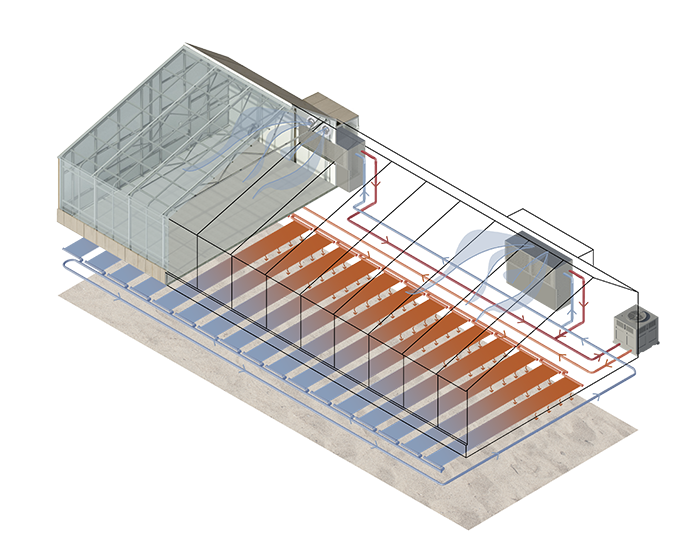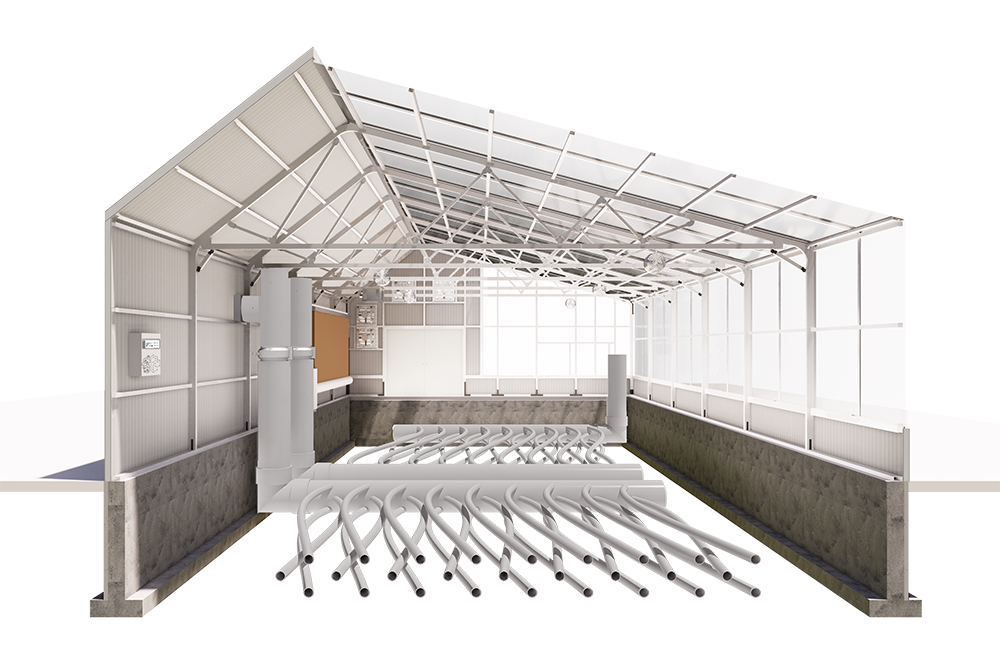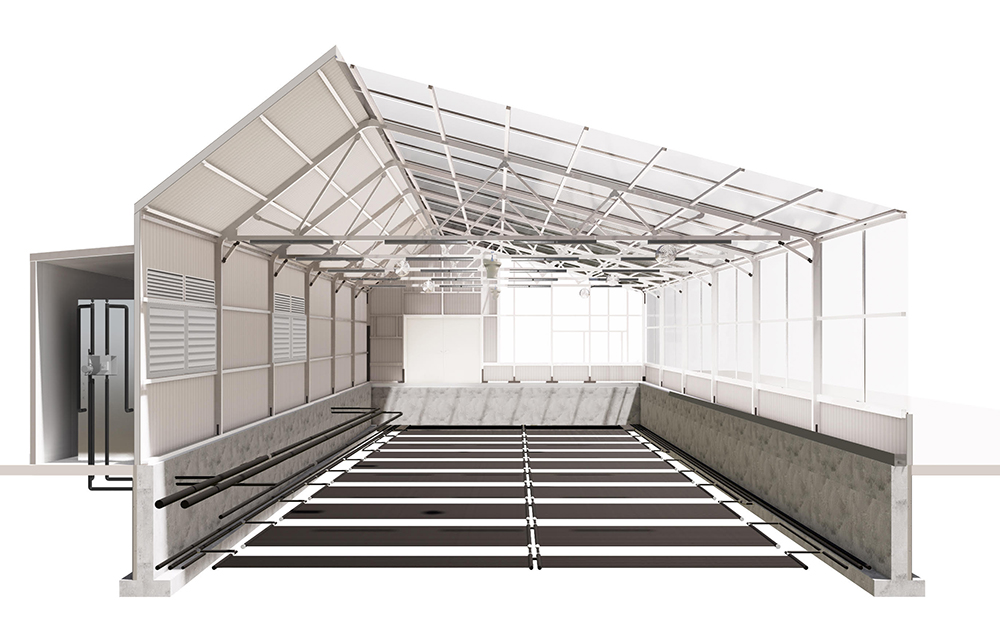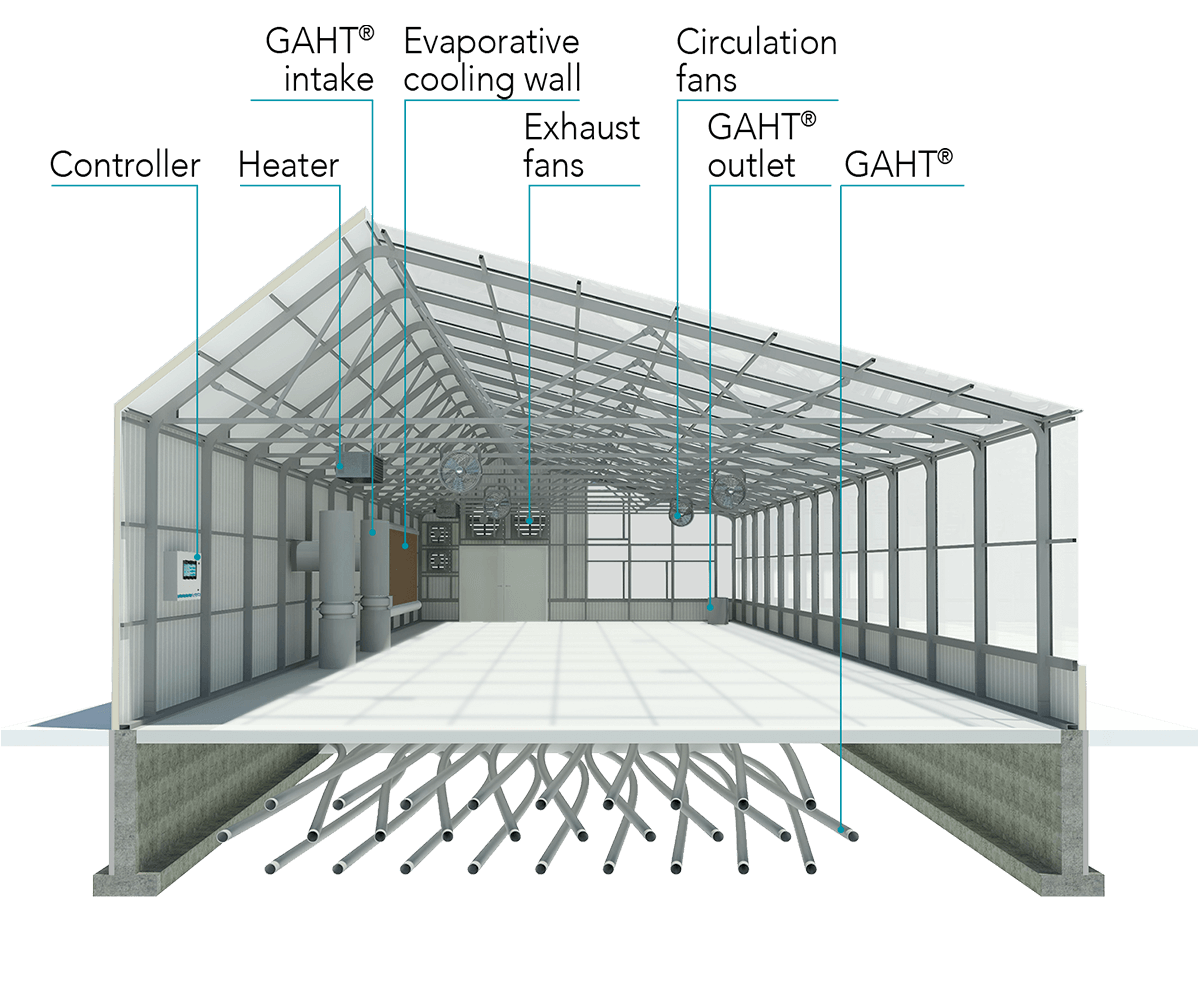Using a geothermal heating and cooling system in your greenhouse is an energy-efficient way to regulate the temperature and humidity in your growing space. So what is geothermal heating & cooling? And is it worth the investment? In this post we will answer both questions as well as compare two different types of geothermal systems to help you decide which one is more appropriate for your greenhouse operation.
Geothermal Energy for Greenhouse Heating and Cooling
Let’s quickly review the basics of geothermal. A geothermal heating and cooling system works by using the steady temperature of the earth below the frostline (55-65°F) to regulate the temperature of a space; in this case a greenhouse.
Some geothermal systems function by just circulating air through underground tubing. The air that is exhausted back into the greenhouse is either cooled or heated by the soil underground. Some common names for these types of systems are Climate Batteries or Earth Tubes. Our version of this type of system is called the GAHT® (ground to air heat transfer) system.
Other geothermal systems function with an HVAC system, using a heat pump and water to transfer heat from the ground to the air. A common name for this type of system is a “Geothermal Ground Loop” or “Ground Source Heat Pump” due to the fact that water is recirculated through underground loops in order to transfer thermal energy from the ground to the heat pump and vice versa. The Ceres version of this type of system is called the EcoLoop™. We will talk more about this type of system below .
The different types of Ceres geothermal systems
Ceres’ two geothermal systems, the GAHT® and the EcoLoop™, range in complexity and capabilities.
The GAHT® system is a simpler design that relies on a circulation fan to push air down an inlet pipe through a series of perforated tubes underground. The air flowing through the GAHT® tubes is either warmed or cooled by the thermal mass of the soil before it’s exhausted back into the greenhouse. This in turn cools or warms the soil. For more information on how a Ceres GAHT® system works, please visit our GAHT® page.
The Ceres EcoLoop™ is a more advanced system, and it’s only available for our sealed greenhouse design: The SunChamber™. The EcoLoop™ is made up of two main components: a heat pump and a ground loop. The heat pump sits above ground behind the north wall of the greenhouse and inside a mechanical shed. Greenhouse air is perpetually recirculated through the heat pump (passing through biofilters) where it is heated, cooled and/or dehumidified. The ground loop works to transfer thermal energy to or from the heat pump. This transfer of thermal energy is accomplished by recirculating water through subsurface piping. The water in the pipes will either disperse or absorb heat to or from the ground depending on if the system is in cooling or heating mode. Both the heat pump and the ground loop components make up one closed loop geothermal system.
In addition to heating and cooling, the Ceres EcoLoop™ also works as a dehumidifier. It does this by intaking air through the heat pump and cooling it to a dew point before reheating it with waste heat recovery back up to the desired set point. The moisture that is drawn from the air during the dehumidification process is reused in the irrigation system. Thus the plants’ transpiration is recycled back to the plants.
For more information on how the EcoLoop™ functions in heating, cooling and dehumidification mode. Please read our blog, Introducing the EcoLoop™: Ceres Most Energy Efficient Heating and Cooling System Yet.
Are geothermal systems worth it?
Yes.
Why choose The GAHT®?
The GAHT® system in and of itself is very cost effective because it requires little energy to run – it just needs enough electricity to run fans. Although, additional heating is generally needed for year round growing.
Some of our growers who have installed a GAHT® system rely solely on the technology to heat their greenhouse all year long, while others have installed additional heaters to maintain optimal growing temperatures in the winter. Reliance on the GAHT® for heating depends on a few different variables: the amount of sun in your greenhouse year-round, what type of plants you’re growing, the size of your greenhouse and outside temperatures in your area.
It’s important to keep in mind that the temperature you can reach with the GAHT® is limited by the amount of energy that’s stored underground, which may not always be enough for optimal growth. We’ll provide examples of different greenhouse scenarios later but, in general, if you’re looking to at least extend your growing season inexpensively, and your grow environment doesn’t require strict temperature regulation, a GAHT® system is a good choice.
Why choose The EcoLoop™?
If you’re running a commercial operation in a sealed greenhouse and need a heating, ventilation, air conditioning and dehumidification (HVACD) system that will help you to achieve precise environmental conditions, the EcoLoop™ is worth considering over a traditional chiller-based HVAC system.
Like the GAHT®, the EcoLoop™’s geothermal properties will save you a lot of money on energy costs.
The biggest benefit of the EcoLoop™ comes from the fact that it combines heating and cooling with dehumidification. Traditionally, dehumidification is the most challenging and energy intensive process in the grow room and usually requires a separate system that works with (or often against) the HVAC system. By combining these two systems, not only does the EcoLoop™ lower the energy demand (by up to 60% compared to a chiller-based HVAC system), it can achieve exact VPD (vapor pressure deficit) levels.
As far as durability goes, The EcoLoop™ has a longer life expectancy than your standard chiller. The lifespan of a heat pump is 20 years and the lifespan of a ground loop is 75.
Also, many utility companies offer large rebates for geothermal systems. It is possible to get 30% back from a renewable energy rebate program, on top of the energy you’re already saving from the system itself. A great choice if you’re growing at a large scale.
What type of geothermal system is right for your greenhouse operation?
The Ceres GAHT® system is designed to work with vented structures, and while it can be purchased by itself, it functions best with Ceres’ passive solar greenhouse design. This is because the sun-harvesting capabilities of Ceres’ design allows for the GAHT® system to collect and store more thermal energy. To see GAHT® specifications and pricing, please visit our GAHT® info page.
You can control a GAHT® system with only simple thermostats, or you can control a GAHT® system in coordination with other equipment in your greenhouse via a climate controller. Ceres’ own controller, the SunSense™ monitors your greenhouse environment and decides when to turn on the GAHT® as well as additional heaters. The SunSense™ also controls the Transition Manifold, an extension of the GAHT®, that allows outside air to heat or cool the greenhouse even further.
An Important Consideration for Geothermal and Greenhouse Design Compatibility
Because the GAHT® was designed specifically to be part of our vented greenhouse solution, it does not have the same level of climate control accuracy as the EcoLoop™ integrated with the SunChamber™ (our sealed greenhouse solution). It is therefore important to evaluate the relevance of strict climate requirements, and/the importance of consistent yields.
To help you understand the GAHT®’s capabilities a little better, here are a few greenhouse climate scenarios:
Scenario 1: Sudbury, Ontario (Canada)
Summer range: 56-78℉
Winter range: (-4) -19℉
Greenhouse size: 30’x60’
Because of its northern location and cold climate, a greenhouse here won’t get a lot of sun and therefore won’t be able to store enough thermal energy to sufficiently heat the grow environment on its own. A GAHT® system will only keep the greenhouse at above 50℉ overnight from March to mid-October. It’s possible that the GAHT® will keep the greenhouse above freezing overnight in the winter but, if you’re growing plants year-round that are sensitive to cold temperatures, you would need a supplemental heater Oct-March.
Scenario 2: Boulder, CO
Summer range: 61-87℉
Winter range: 22-42℉
Greenhouse size: 30’x60’
Even though a place like Boulder gets really cold during the winter, a greenhouse in this location gets a lot of sun year-round. A GAHT® system makes more sense here for year-round production because of the heightened energy input from the sun – even when it’s cold outside. A properly designed GAHT® will keep the overnight temperature of this greenhouse above 60°F for the whole year with maybe the exception of 2-4 weeks of extreme cold weather. If supplemental lighting is used that generates a lot of heat, it will be even easier to keep the greenhouse above 60°F overnight.
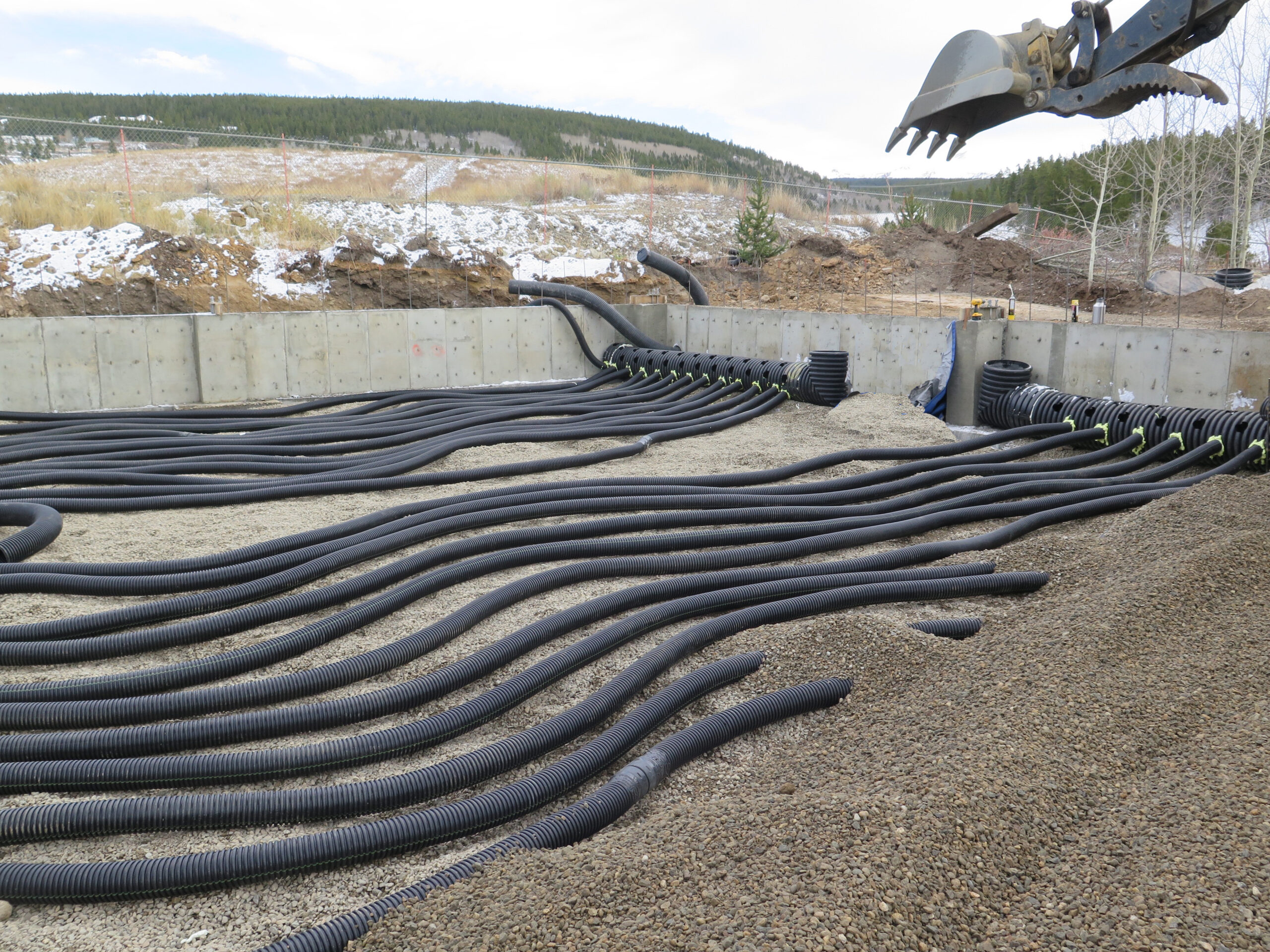 Greenhouse size: 12×18
Greenhouse size: 12×18
It’s important to note that this size of greenhouse in the same location (Boulder, CO) will have a harder time keeping temperatures above 60°F year round because it has a higher wall and roof surface area ratio vs its floor area as compared to a larger greenhouse. This causes it to have a higher heat loss per sq.ft. as compared to a larger greenhouse. A properly designed GAHT® will keep the overnight temperature above ~45°F for the months of January and February. If the grower wishes to achieve 60°F overnight, they will most certainly require supplemental heat. The rest of the year, the GAHT® shouldn’t have a problem keeping temperatures above 60°F overnight.
Scenario 3: Anacortes, WA
Summer range: 54-71℉
Winter range: 37-45℉
Greenhouse size: 23’x36’
A location like Anacortes, Washington, being in the Pacific Northwest, experiences relatively mild temperatures year-round but doesn’t get a lot of sun in the winter. A GAHT® system in this location shouldn’t have a problem keeping a Ceres greenhouse above 50℉ overnight from mid-February until the end of October. Even in December and January, the GAHT® is likely to keep the greenhouse temperatures above 45℉ overnight. Because of the lack of sun during these months, the energy stored underground will be slowly depleted over the course of the winter, because the GAHT® won’t be able to fully recharge during the day.
It’s important to mention that the GAHT® can also be built externally, to an already existing greenhouse. This approach has its own benefits, especially when it comes to cooling. For more information on this topic, please read our blog, Adding a GAHT® to an Existing Greenhouse.
The EcoLoop™ is more expensive than the GAHT® system at about $55-$70 per square foot. It integrates solely with the Ceres SunChamber™ (our sealed facility), making it more appropriate for commercial cultivators who require precise climate control for production. The EcoLoop™’s temperature, humidity and VPD settings are monitored and controlled by the Ceres SunSense™ controller. The SunSense™ also monitors CO2, leaf/ canopy temp, Photosynthetic Active Radiation (PAR), outdoor weather conditions, energy consumption and many other things.
The EcoLoop™ and the SunSense™ controller are integral components of our SunChamber™, sealed greenhouse solution. We recommend this whole systems solution to commercial cultivators operating in extreme climates and/or those growing high-value crops.
In conclusion, there are obvious energy saving benefits to installing a geothermal heating and cooling system for your greenhouse. The question is what type of geothermal system is right for your situation? The choice of whether to go with a GAHT® system or EcoLoop™ for your greenhouse will depend on your budget, climate, greenhouse size and growing goals. A GAHT® system, or climate battery, works best with vented greenhouses and in places where it can store a sufficient amount of solar energy underground at any time of the year. But if you’re looking for precise and consistent climate control year-round, and you have the budget for it, the Ceres EcoLoop™ integrated into the SunChamber™ might make more sense.
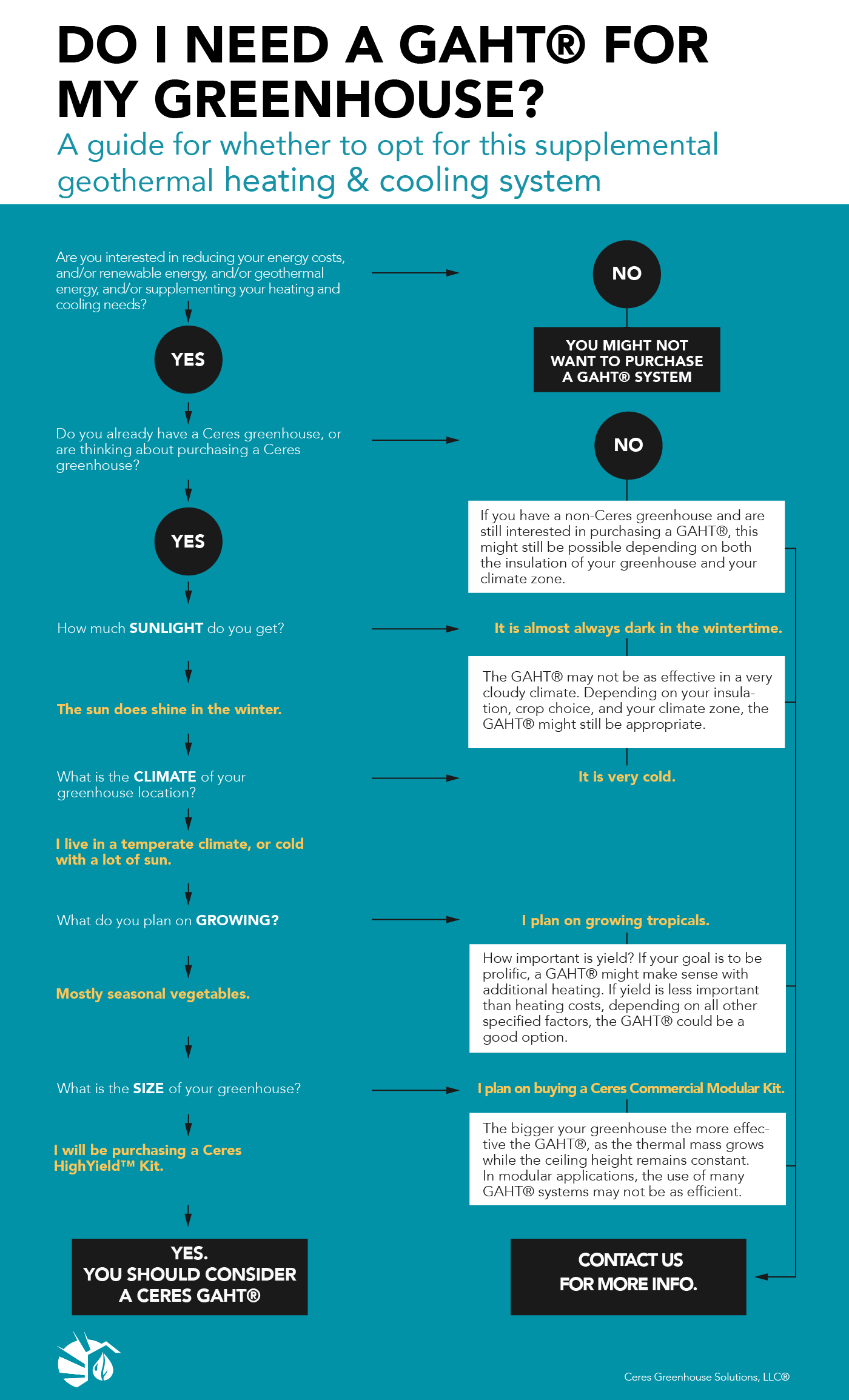 For more information, or to talk to a Ceres greenhouse expert, contact us today!
For more information, or to talk to a Ceres greenhouse expert, contact us today!

